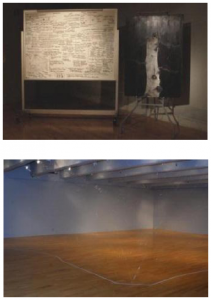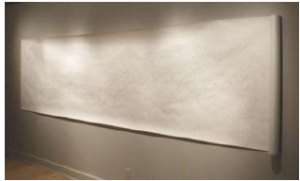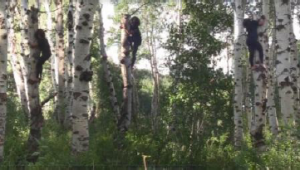Hannah Wertz and Professor Sunny Taylor, Department of Visual Arts
Abstract and Justification for “Exhibit A”, on public display October 17-31, 2011
Exhibit A is an explanation in four parts, of my attempt at knowing more about the Populus Tremulus (Aspen Tree). Eighteen months ago my experiments started shallow by painting portraits of the tree as seen in “Level One”. After six months the results were not leading my beyond surface physicality so I decided to try science. I represented this period by a white board, “Level Two”, covered in with written information about the tree collected over the last year from books, lectures, articles, professionals, botany, and environmental literature classes.
A turning point came in April 2011 after reflection on the process of struggling to remember chemistry and numbers. I realized that my lab work at present would probably just end up being bad science. But I had a new perception after learning all the facts and realized that this tree also physically depended on a million other living things each with an equal amount of necessary parts with the same explosion of knowledge at whatever direction I turned. The impossibility of this project in truly achieving a conclusion about one single tree overwhelmed me and inspired the piece, “I still don’t know anything really”. This installation was aimed at representing the eternal process of learning by physically replicated the volume of one cross section of a plant cell as a temporary fixture in the gallery. Using monofilament (fishing line), I spent fifty hours stringing the line wall to wall and floor to ceiling to fill an area of about 40x20x10 square feet using about a mile of fishing line. People responded with curiosity and it sparked conversations about time and effort put into pursuing knowledge.
Here I saw a need to try a deeper application of what I was learning by putting my life under a similar lens of scientific observation wondering at the possibility of understanding myself better. The drawing, “The Relative Frequency and Position of Positive and Negative Emotions Over 365 Days”, represents this experiment in self-examination by measuring my happiness on a scale of 1-10 over the last year by reading my journals and plotting emotions on 10X3’ roll of paper. This had to be done numerically to avoid hiding the dramatic parts of high/low points of my experiences that naming them individually would have inspired. The scientific method allowed me to be objective about an emotionally charged subject; the abstract, impersonal nature of science became a means toward a very personal end. I saw growth visually similar to a tree ring and earned a new self-awareness. Ironically, I had been trying to avoid studying my own life and digging into my past by studying a tree, but here I opened my heart into the project and the tree became a variable and testament to the real importance of expanding the human perception.
This awakening is discussed in the video, “Let’s Try Climbing It”, showing the need for sensory experience that looking and talking cannot provide. I recorded myself climbing the aspen tree three times at three different angles that is slow and methodical, but inherently progressive. In a real sense, this tree has now been appropriated into my life with a bond that has become stronger with every second that I spend with it. Time is the most important element in the development of this work. I have spent equal time with this tree that I would have spent in a relationship with a person; touching it, climbing it, writing about it, and thinking about it when it isn’t there. These art pieces visually represent my study of one single object; pointing to the exponential spiritual growth possible from a similar process. I believe this growth outweighs the value of any solid conclusions about the object itself.
Because of this project, my art-making has expanded to include any medium and field of study necessary to open and renew human perceptions of the world. My process is a conceptual, Cubist breakdown of the familiar (a tree) reconstructed in new situations in order to explore how humans could change stigmas and stereotypes that prevent true comprehension of physical surroundings. This meaningful change, which has become my motivation for making art, requires a literal movement and rewiring of the brain; moving it out of its normal Gestalt patterns and gently, but creatively guiding a mind toward other patterns of interpretation. If I can succeed in creating an experience that removes the psyche outside of its normal habits, by using a Freudian concept of re-contextualizing the familiar, there is a precious opening made through which topics of emotional, physical, and spiritual gravity about human experience can be discussed in a safe, unifying, and non-shocking way. For my audience and me, repeating this break-down experience might be every day and the more times we do this, the more we can experience meaningful change— like water slowly wearing down a riverbed revealing new paths and a sublime glimpse of a truly open human mind. I’m hoping that moving outside typical means of calculation, measurement and imitation will give the intellect those small visions of the sublime to feed a desire to know more and know deeper; to use new equations and variables from the human experience that will lead to continually different and temporary conclusions.
Artist Statement written for public view at the exhibition
May 2010: Walked into the North Rim Campground at the Grand Canyon and left wanting to know more about Aspen trees. Plan to study all aspects of one tree with blind experimentation using art and amateur scientific process.
October 2011: Conclusion: N/A. Only documentation of time spent exploring using books and numbers and drawings and lectures trying to understand this living thing. Results include, but not limited to, observations on humility, inward realization of deeper connection to natural processes, appreciation of process of experimentation [where making one choice multiplies knowledge exponentially], a personal relationship with an inanimate object. Still evading total comprehension [see Exhibit A].



